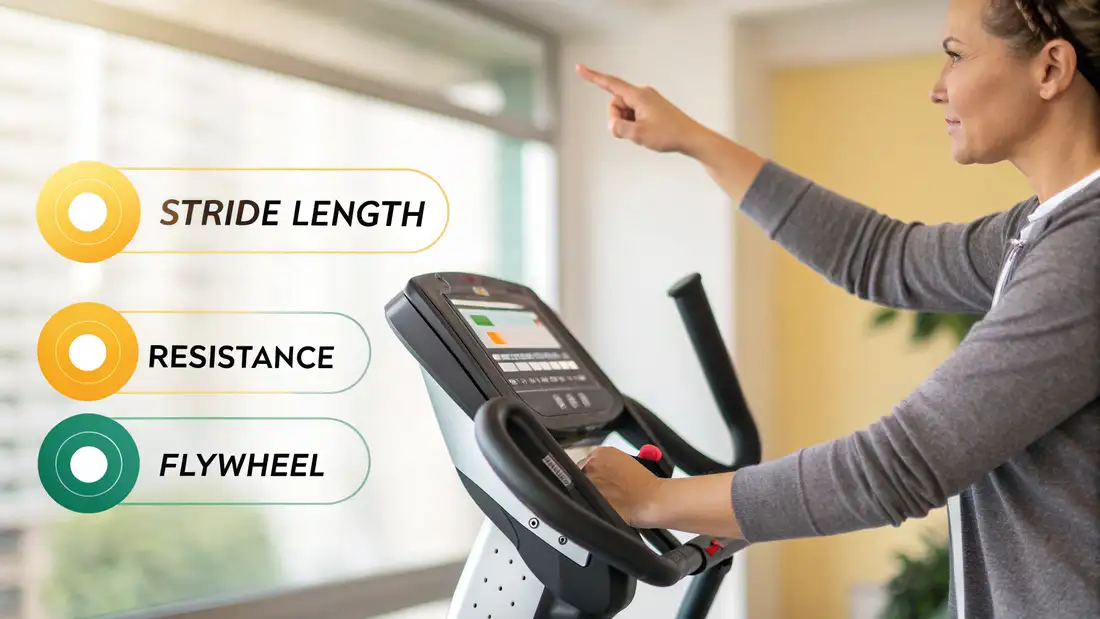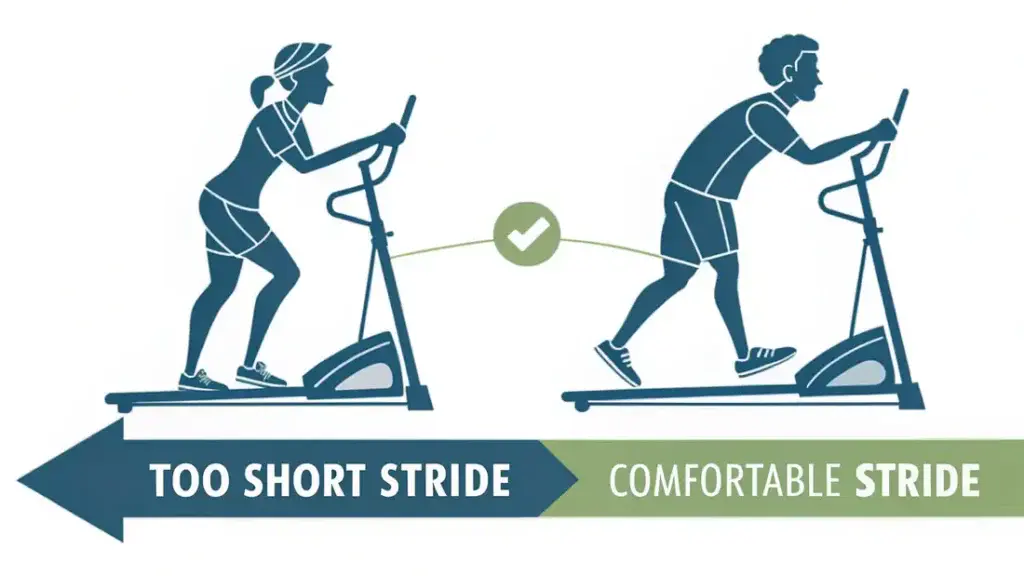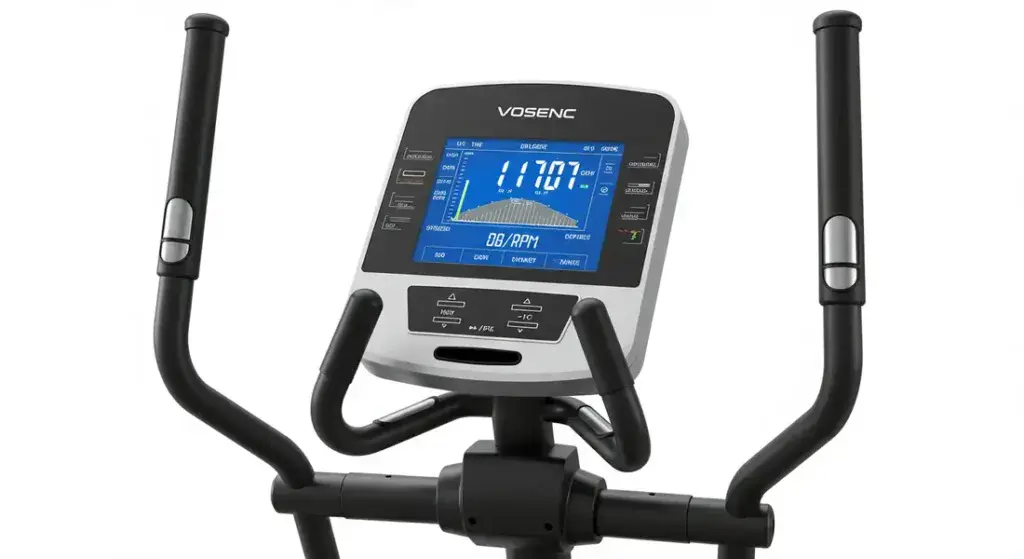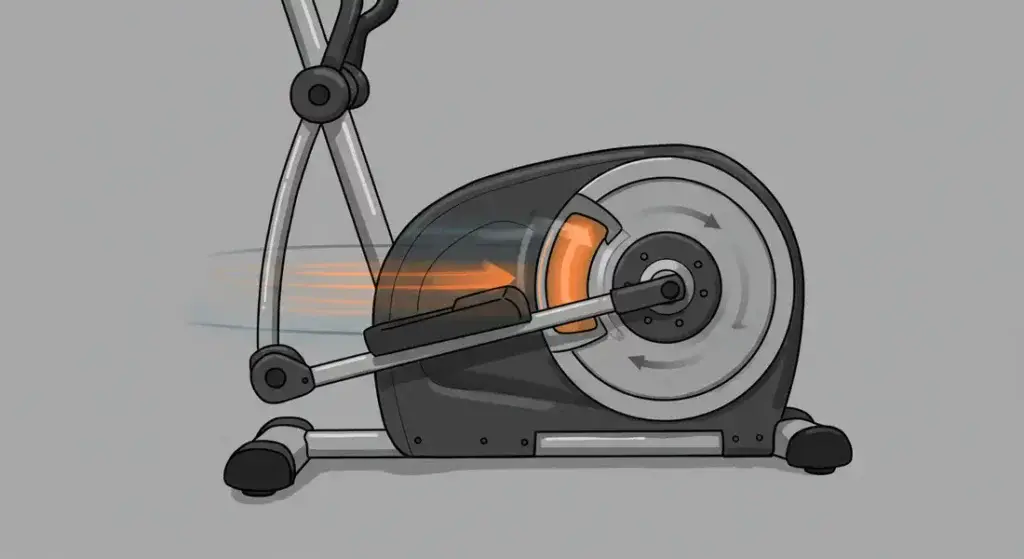So, you’ve decided an elliptical is the perfect low-impact cardio machine for your home gym. Fantastic!
But then you start browsing models, and suddenly you’re drowning in an alphabet soup of specs: stride length, ECB magnetic resistance, flywheel weight, console programs… It’s enough to make anyone’s head spin!

How do you know what actually matters, especially when buying your very first machine?
Feeling lost in the technical jargon is completely normal. That’s why we’ve created this guide.
Think of it as your personal translator and prioritization tool for navigating the often-confusing world of elliptical specifications.
We’re cutting through the marketing hype to focus squarely on the essential elliptical features that will directly impact your comfort, the quality of your workouts, and whether you’ll actually stick with your new fitness routine long-term.
Forget trying to become an engineering expert overnight.
We’ll break down what the key features mean in plain English, explain why they matter specifically for beginners, show you how to evaluate them practically (even without trying the machine!), and help you understand where you can potentially save money by skipping the bells and whistles… for now.
Let’s decode those specs!
Tier 1 – The Non-Negotiables to Get These Right for Comfort & Basic Use
Think of these two features as the absolute foundation of a good elliptical experience.
If a machine falls short here, fancy consoles or extra programs won’t make up for it. Prioritize these above all else!
Feature #1: Stride Length – The Unsung Hero of Comfort

- What it is (Simply): Imagine taking a step while walking or running. Stride length on an elliptical is the maximum distance (front-to-back) your feet travel with each “step” or rotation of the pedals. It’s measured in inches (or cm).
- Why it’s CRUCIAL for Beginners: This is arguably the single most important factor for determining if an elliptical will feel comfortable and natural for your body. If the stride length is too short for your height, it will feel like you’re taking tiny, choppy, restricted steps – incredibly awkward and uncomfortable. If it’s excessively long, you might feel like you’re overstretching. An uncomfortable machine is a machine you won’t use. Period.
- Practical Evaluation (How to Check):
- General Height Guidelines (Use as a Starting Point Only):
- Users under 5’3″ (160cm): Often find 16-18 inches comfortable.
- Users 5’3″ – 5’10” (160-178cm): Typically prefer 18-20 inches.
- Users over 5’10” (178cm+): Usually need 20 inches or longer (22″ is common on higher-end models).
- Disclaimer: These are just averages! Leg length vs. torso length varies. Personal preference matters most.
- The “Feel” Test (If Trying In-Person – Highly Recommended!): This trumps any guideline. Get on the machine and move at a moderate pace. Does it feel smooth and natural, like a brisk walk or easy jog? Or do you feel confined (“baby steps”)? Do your hips rock uncomfortably? Are you stretching too far? Trust your body’s feedback.
- What About Adjustable Stride? Some premium ellipticals offer adjustable stride lengths. This is fantastic for households with multiple users of different heights, but it significantly increases the cost. For most beginners buying their first machine, finding a comfortable fixed stride is the goal.
- General Height Guidelines (Use as a Starting Point Only):
- Bottom Line: Do not compromise on stride length. Finding one that fits your body comfortably is paramount for long-term use and enjoyment. It’s worth spending slightly more for the right fit here than saving money on a machine you’ll hate using.
Feature #2: Smooth & Sufficient Resistance – Your Workout Engine
- What it is (Simply): This is the mechanism that makes it harder or easier to pedal, providing the challenge for your muscles and cardiovascular system.
- Why it’s CRUCIAL for Beginners:
- Progression: You need resistance levels that start easy enough for your current fitness level but go high enough to challenge you as you get stronger. This ability to gradually increase the difficulty (progressive overload) is fundamental to improving fitness.
- Smoothness: The transition between resistance levels should feel seamless and fluid. Jerky or clunky resistance makes for an unpleasant and potentially less effective workout.
- Motivation: If the easiest setting is too hard, or the hardest setting becomes too easy quickly, you’ll lose motivation.
- Practical Evaluation (How to Check):
- Resistance Type Matters: Look for Magnetic Resistance (specifically ECB – Eddy Current Brake magnetic resistance if listed). This type uses magnets to create resistance without physical contact, resulting in a much smoother, quieter, and more reliable experience than older, friction-based systems. Pretty much any decent elliptical today uses magnetic resistance.
- Test the Smoothness: If trying in person, change resistance levels up and down. Does it adjust quickly and smoothly? Or is there a lag or a jolt?
- Check the Range (Crucial!):
- Start at the lowest setting. It should feel very light, almost effortless.
- Crank it up to the highest setting. Even if you can only hold it for a few seconds, does it feel genuinely challenging? You need this top-end range to grow into. Don’t buy a machine where you can easily spin at the highest level on day one.
- Don’t Obsess Over the Number of Levels: Whether a machine has 16, 20, or 32 levels is less important than the quality of the resistance (smoothness) and the actual difficulty range from easiest to hardest. More levels can allow for finer adjustments, but the overall range is key.
- Bottom Line: Seek out smooth, quiet magnetic (ECB) resistance with a wide range – easy enough to start, and challenging enough to keep you progressing for a long time.

Tier 2 – The Control Center & Performance Core in Defining Your Workout Experience
Once you’ve nailed comfort and basic workout capability, these features define how you interact with the machine and its underlying performance.
Feature #3: A Usable Console & Key Metrics – Your Dashboard
- What it is (Simply): The screen and buttons – your command center for controlling the workout and tracking your performance.
- Why it Matters for Beginners: Provides essential feedback for motivation (seeing distance covered, time elapsed) and helps you monitor intensity (speed/RPM, heart rate). It needs to be easy to read and operate while you’re moving.
- Practical Evaluation (What Beginners Really Need):
- Essential Metrics: Don’t get lost in endless data streams. Focus on clarity for:
- Time: How long you’ve been working out.
- Distance: Virtual distance covered (miles or km).
- Speed (or RPM): How fast you’re moving the pedals (Revolutions Per Minute).
- Resistance Level: The current difficulty setting.
- Estimated Calories Burned: A motivational estimate (accuracy varies).
- Heart Rate: Basic pulse reading (more on accuracy later).
- Readability & Ease of Use: Is the screen backlit (easier to see in various lighting)? Are the numbers large enough? Are the buttons intuitive and easy to press without stopping? A simple, clear interface is better than a cluttered, confusing one.
- Basic Programs are a Bonus: While dozens of pre-set workout programs might look impressive, as a beginner, you’ll likely spend most of your time in “Manual” mode, controlling the resistance yourself. A few basic programs (like Intervals, Hills, Target Heart Rate) are nice to have for variety later, but not essential to start.
- Essential Metrics: Don’t get lost in endless data streams. Focus on clarity for:
- Bottom Line: Prioritize a clear, easy-to-read console that displays the essential metrics reliably. Don’t overpay for complex program menus you might not use initially.

Feature #4: Flywheel Weight (Demystified) – The Smoothness Factor
- What it is (Simply): A weighted metal disc housed within the drive system. When you pedal, it spins, creating momentum that helps smooth out the stride motion.
- Why it Matters (Generally): All else being equal, a heavier flywheel tends to contribute to a smoother, more stable, and more continuous-feeling ride. It minimizes that jerky, start-stop feeling, especially when you change speeds or resistance levels. Lighter flywheels can sometimes feel choppy.
- Practical Evaluation (Rule of Thumb for Beginners):
- There’s No Single Magic Number: Specs vary, and manufacturers measure differently. However…
- General Guideline: Flywheels weighing around 15-20 pounds (approx. 7-9 kg) or more often provide a noticeably smoother experience compared to very light flywheels (under 15 lbs). Premium machines might have flywheels of 30 lbs or more.
- Connect it to the “Feel”: Don’t buy based only on flywheel weight! A heavy flywheel paired with poorly designed mechanics won’t feel smooth. Use the weight spec as a guideline but always prioritize the actual feel of the machine’s smoothness during your resistance test (see Tier 1).
- Bottom Line: Heavier flywheels generally contribute to smoother motion. Aim for something in the 15-20 lbs+ range if possible, but let the overall smooth feel be your ultimate guide.

Tier 3 – Important Supporting Actors in Enhancing Your Workout & Longevity
These features add significant value and contribute to a better overall experience or the machine’s durability.
They might be secondary to Tier 1 depending on your budget, but they are important considerations.
- Incline Capability: Allows you to raise the angle of the elliptical path, simulating hill climbing.
- Benefit: Increases workout intensity significantly, targets different muscles (more glutes and hamstrings), adds workout variety.
- Priority: A fantastic feature for boosting challenge and preventing plateaus, but often found on mid-range and higher models. Not strictly essential for your very first machine if the budget is tight, but highly desirable if affordable. (Keywords: elliptical incline feature, benefits of elliptical incline)
- Build Quality & Weight Capacity: How sturdy and well-constructed the machine is.
- Benefit: Ensures stability (less wobbling or shaking during use!), promotes durability for long-term use, and enhances safety.
- Evaluation: Check the manufacturer’s maximum user weight capacity – ensure it comfortably exceeds your weight (by at least 20-50 lbs for a safety margin). Look for metal components vs. excessive plastic. Does it feel solid when you step on it? (Keywords: elliptical weight capacity, sturdy elliptical build, elliptical durability)
- Heart Rate Monitoring Options: How the machine measures your pulse.
- Benefit: Helps you gauge workout intensity and potentially train within specific heart rate zones.
- Options:
- Grip Sensors (Hand Pulse): Built into the static handlebars. Convenient but notoriously less accurate, influenced by grip pressure and movement. Okay for a very basic awareness.
- Wireless Chest Strap Compatibility: The machine can receive signals from a separate chest strap transmitter (often sold separately). This is far more accurate and reliable for serious training.
- Priority: Chest strap compatibility is a definite plus if you plan to do heart rate zone training, but grip sensors are adequate for casual monitoring initially. (Keywords: elliptical heart rate monitor, chest strap compatible elliptical, accurate heart rate elliptical)
Tier 4 – The “Nice-to-Haves” & Features to (Maybe) Ignore Initially
These features add convenience or entertainment value but typically don’t impact the core workout quality as much as the features above.
Don’t let them sway your decision if the fundamentals aren’t solid!
- Examples: Integrated tablet holders (very useful!), water bottle holders (basic ones are essential, fancy ones less so), built-in cooling fans, Bluetooth connectivity for syncing with fitness apps (can be highly motivational but adds cost), extensive libraries of pre-set workout programs, built-in speakers.
- The Advice for Beginners: These are bonuses. Ensure the machine has a comfortable stride, smooth/sufficient resistance, a clear console, and solid build quality first. You can often add a cheap tablet holder, use your phone for apps, or place a floor fan nearby later if needed. Focus your budget on the core mechanics.
Prioritization Cheat Sheet for Beginners
Feeling overwhelmed? Use this checklist when comparing models:
Elliptical Features Prioritization Checklist
| Priority Tier | Feature | Why it Matters Most for Beginners | Key Consideration |
| MUST-HAVES | 1. Comfortable Stride Length | Comfort = Usage! Prevents awkward/painful workouts | Fits YOUR height; Test feel if possible |
| (Focus Budget) | 2. Smooth & Sufficient Resistance | Allows progression; Makes workout enjoyable | Magnetic (ECB); Wide range (easy start, hard finish) |
| VERY IMPORTANT | 3. Clear, Usable Console | Tracks progress; Easy interaction during workout | Shows essential metrics clearly; Easy to read/use |
| (Next Priority) | 4. Decent Flywheel Weight | Contributes to smooth motion | Aim for 15-20lbs+ as guideline; Assess overall feel |
| 5. Solid Build Quality & Weight Capacity | Stability, Durability, Safety | Check weight limit; Feels sturdy, less wobble | |
| CONSIDER IF… | 6. Incline Feature | Adds intensity & variety; Targets different muscles | Great upgrade if budget allows |
| (Budget/Goals) | 7. Wireless Heart Rate Compatibility | Accurate heart rate tracking for training | Needed for serious HR zone training; Grips are basic |
| BONUS FEATURES | 8. Tablet Holder, Fan, Apps, Programs etc. | Convenience & Entertainment | Nice extras, but don’t sacrifice core features for them |
Conclusion – Focus on Fundamentals for Long-Term Fitness Success
Choosing your first elliptical might seem daunting with all the technical specifications flying around.
But by focusing on the truly essential elliptical features, you can cut through the noise and make an informed decision that sets you up for success.
Prioritize what directly impacts your comfort and ability to get an effective workout: a stride length that fits your body and smooth, sufficient resistance that allows you to progress.
Then, ensure you have a clear console, decent flywheel weight contributing to smoothness, and solid build quality.
Get these fundamentals right, and you’ll have a machine you enjoy using for years to come.
Don’t be dazzled by fancy extras until the core components meet your needs.
Invest wisely in a solid foundation, and you’ll be gliding your way to better fitness in no time!
Now that you know what features to look for, what’s next?
Understand how these features might vary based on machine design: Explore Types of Ellipticals Explained.
Get the bigger picture: Return to our main Beginner’s Guide to Ellipticals.
Which elliptical feature still seems the most confusing or important to you? Do you have any questions about specific specs?
